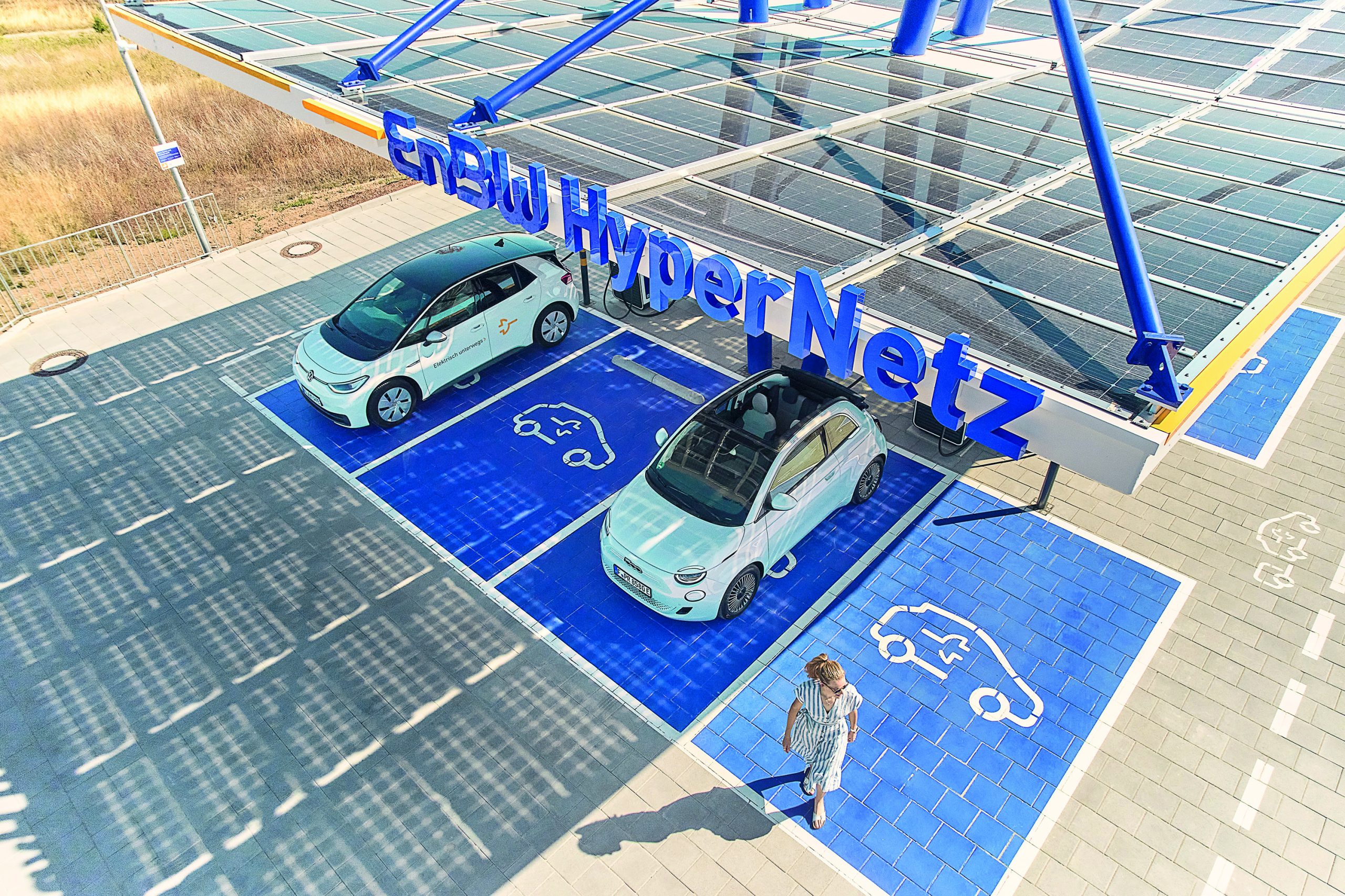 Auch Schnellladestationen werden zunehmend mit Solardächern ausgestattet. Foto: EnBW/Endre Dulic
Auch Schnellladestationen werden zunehmend mit Solardächern ausgestattet. Foto: EnBW/Endre Dulic
Parking lot operators can make an essential contribution to climate protection and zero-emission mobility by installing charging facilities with solar roofing. And they can also enhance the image of desolate areas with aesthetically pleasing solutions. A guest article by Peter Grett in the current eMove360° magazine in german language.
As current studies show, the operation of e-cars is more environmentally friendly than that of combustion vehicles even if the share of green electricity is only 48 percent, as is the case with the current German mix. Nevertheless, efforts should be intensified to generate the charging current increasingly from renewable energy sources, ideally at the point of “refueling” itself. Solar charging ports are a predestined solution here, especially in public areas, mobility hubs, parking lots on company premises, and at hotels and leisure facilities.
SOLAR OBLIGATION ON PARKING LOTS
Step by step, a solar obligation for commercial parking lots of non-residential buildings is being introduced in Germany at the state level. Depending on the federal state, this applies to newly installed spaces such as those at shopping markets or hotels. In North Rhine-Westphalia and Baden-Württemberg, this requirement has already been in place since January 2022 and affects all newly built, open parking spaces with more than 35 parking spaces; in Rhineland-Palatinate and Hesse, the limit is 50 parking spaces, and in Schleswig-Holstein, 100. At least, if the parking space is suitable for solar use. What is meant by this is regulated individually by each federal state. If these requirements are met, it is mandatory in Baden-Württemberg, for example, to equip at least 60 percent of the parking space with photovoltaic modules.
REQUIREMENT FOR THE CREATION OF CHARGING FACILITIES.
At the same time, the Federal “Building Electric Mobility Infrastructure Act” (GEIG) stipulates in Section 7 that persons or companies constructing a building that has more than six parking spaces within or on an adjacent site must equip at least every third parking space with the line infrastructure (empty conduits) for electric mobility and must also construct at least one charging point.
SOLAR CHARGING CARPORTS PAY OFF SEVERAL TIMES OVER
The environment is not the only one to benefit from solar charging solutions; providers of public and semi-public charging stations for electric vehicles are now also reaping financial rewards, including the so-called GHG premium. This is a tradable emissions certificate. Its price development is dynamic and depends on supply and demand. Until now, mainly electricity suppliers of charging points could participate in GHG quota trading. But with the current regulation, operators of charging stations can now benefit as well as owners of battery-electric vehicles. To do so, charging stations must be (semi) public, compliant with calibration laws and registered with the Federal Network Agency. Harald Baumeister, managing director of Sopago GmbH, a company specializing in solar canopies, provides the following calculation example: “If a company operating charging stations sells 10,000 kilowatt hours of green electricity per year for 42 cents per kilowatt hour each, it receives 4,200 euros plus a GHG premium of 1,900 euros (19 cents per kilowatt hour), for a total of 6,100 euros per year. The GHG premium increases revenue here by more than 45 percent.
SOLAR CHARGING PORTS AS A VISIBLE SIGN OF SUSTAINABILITY
Solar carports offer private individuals, companies and public authorities a good opportunity to demonstrate a perceptible link between green electricity generation and e-mobility. Especially in the hotel and restaurant industry, there is an increasing emphasis on communicating one’s own sustainability credentials to guests. However, guests cannot directly experience many of the corresponding measures, which is another reason why hoteliers and operators of leisure facilities are increasingly offering them charging options for their electrified vehicles. Those who do not “hide” the chargers in the back corner of the underground parking garage, but install them in the parking lot, send a visible signal of their sustainability profile and modern mobility awareness. All the more so if the charging boxes are coupled with solar power generation. It is possible to choose more soberly pragmatic solutions, but also to send spectacular signals of sustainability in the form of exceptionally designed products. As the following example shows.
SOLAR LOADING TULIPS
The company MDT-tex is a global specialist in textile outdoor architecture. Its core business includes the manufacture and sale of solar shading systems with innovative membrane coatings. With the “Solar Solutions” product range, the company is now bringing together the topics of aesthetic sun protection, sustainable power production from solar cells and e-mobility. In addition, rainwater can also be collected via the tulip-shaped charging screens. The energy generated can either be used directly, stored or alternatively fed into the public power grid. One shady “tulip” serves as a shelter and charging point for two electric vehicles, while several umbrellas are arranged in a modular fashion either side by side in a row or as a group. Their function is not limited to EV charging alone. They can be expanded to include seating and charging options for mobile devices, for example.
Read this and other articles on electric mobility and autonomous driving in the current eMove360° magazine in german language. Download the free PDF here or order the print version in the shop.